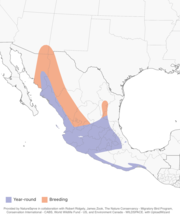
The Apodiformes is an order, or taxonomic grouping, of birds which traditionally contained three living families—the Apodidae (swifts), the Hemiprocnidae (treeswifts), and the Trochilidae (hummingbirds); however, in the Sibley-Ahlquist taxonomy, this order is elevated to the superorder Apodimorphae, in which hummingbirds are separated into a new order, the Trochiliformes. With nearly 450 species identified to date, it is the most diverse order of birds after the Passeriformes.

The broad-billed hummingbird is a small-sized hummingbird that resides in Mexico and the southwestern United States. Males and females have different features. The juveniles resemble the female adult more than the male adult. The broad-billed hummingbird is a bright coloured bird with a broad and bright red bill. The bird is also known for its other common names – the Colibrí Pico Ancho in Spanish and Colibri circé in French. It is more active during the day and less active during the night.
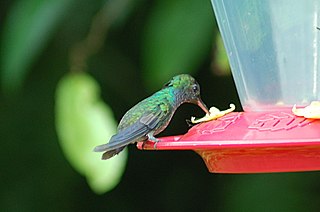
The purple-chested hummingbird is a species of hummingbird in the family Trochilidae. It is found in Colombia and Ecuador. Its natural habitats are subtropical or tropical moist lowland forest and heavily degraded former forest. It is commonly hunted for the supposed medicinal properties of its beak by indigenous peoples in the area.

The visorbearers are hummingbirds in the bitypic genus Augastes in the family Trochilidae.

Chlorestes is a genus of hummingbirds.

Chlorostilbon is a genus of hummingbird in the family Trochilidae, known as emeralds. A single species, the blue-chinned sapphire is variously placed in the monotypic genus Chlorestes or in Chlorostilbon. The taxonomy of the C. mellisugus superspecies is highly complex and, depending on view, includes 1-8 species. All species in this genus have straight black or black-and-red bills. The males are overall iridescent green, golden-green or bluish-green, and in some species the tail and/or throat is blue. The females have whitish-grey underparts, tail-corners and post-ocular streak.

The golden-crowned emerald is a species of hummingbird in the "emeralds", tribe Trochilini of subfamily Trochilinae. It is endemic to western Mexico.

The dusky hummingbird is a species of hummingbird in the "emeralds", tribe Trochilini of subfamily Trochilinae. It is endemic to Mexico.

The caribs are a genus, Eulampis, of hummingbirds in the family Trochilidae. The genus contains two species, both of which are endemic to the islands of the Caribbean. The genus name comes from the Ancient Greek word eulampēs meaning 'bright shining'.
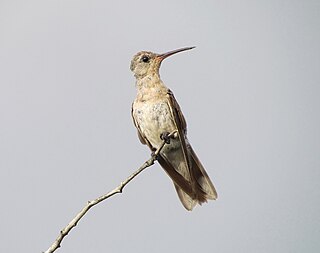
The buffy hummingbird is a species of bird in the hummingbird family Trochilidae. It is the only species placed in the genus Leucippus. This bird lives in dry forest and scrubland in northern South America where it feeds on insects and the nectar, flesh, and juice of cactus fruits.

The metaltails are a group of hummingbirds in the genus Metallura. The species are distributed along the Andes.

The hillstars are hummingbirds of the genus Oreotrochilus. They are native to the Andes in South America.

Schistes is a genus of hummingbirds in the family Trochilidae. It was long considered to have only one species, the wedge-billed hummingbird but this species was split. The genus now includes two species:
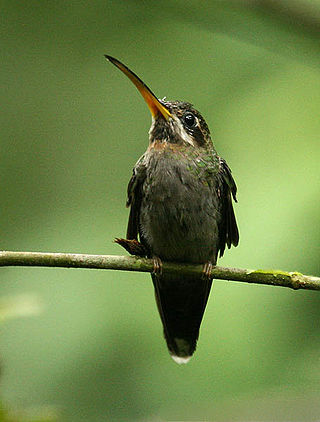
The barbthroats are a genus Threnetes of South American hummingbirds in the family Trochilidae.

Saucerottia is a genus of birds in the family Trochilidae, or hummingbirds.
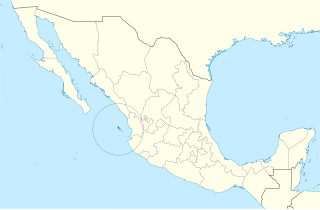
The Tres Marías hummingbird is a Near Threatened species of hummingbird in the "emeralds", tribe Trochilini of subfamily Trochilinae. It was formerly considered to be a subspecies of the broad-billed hummingbird. It is endemic to the Islas Marías island group off the west coast of Mexico.
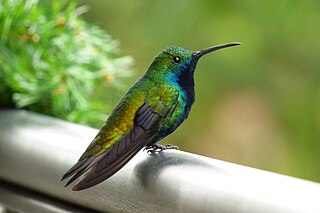
Polytminae is one of the six subfamilies of the hummingbird family Trochilidae. The subfamily contains 12 genera with a total of 29 species.

Heliantheini is one of the two tribes that make up the subfamily Lesbiinae of the hummingbird family Trochilidae. The other tribe in the subfamily is Lesbiini.

Lesbiini is one of the two tribes that make up the subfamily Lesbiinae in the hummingbird family Trochilidae. The other tribe is Heliantheini (brilliants).
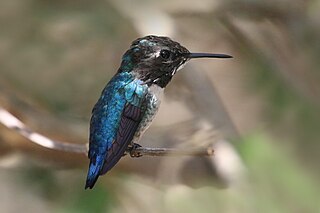
Mellisugini is one of the three tribes that make up the subfamily Trochilinae in the hummingbird family Trochilidae. The other two tribes in the subfamily are Lampornithini and Trochilini (emeralds).


